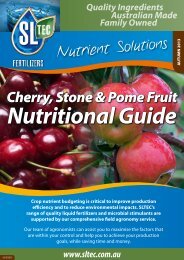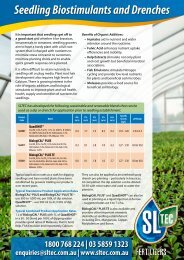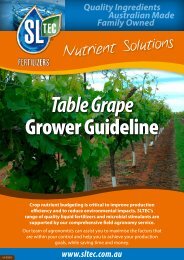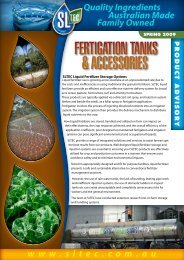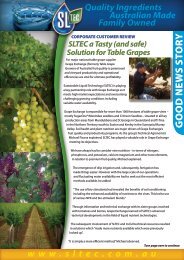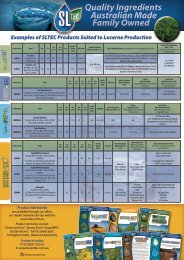Broadacre Nutritional Guide - Sustainable Liquid Technology
Broadacre Nutritional Guide - Sustainable Liquid Technology
Broadacre Nutritional Guide - Sustainable Liquid Technology
Create successful ePaper yourself
Turn your PDF publications into a flip-book with our unique Google optimized e-Paper software.
Product Technical Information Typical Application RatesProductCodeSeed DressingSG0019SG0007At SowingSS9001SS9003NameBiokelp & Z MoZn 3%, Mo 0.05%, B 0.002%,Kelp 16.4%,QuadSHOTN as NO 30.4%, P as PO 41.7%,Zn 0.001%, B 0.002%,Fe 0.007%, Fulvic Acid 0.2%, FishEmulsion 7.3%, Humic Acid 6.0%,Kelp 7.3%, Molasses 7.3%N%(w/v)P%(w/v)K%(w/v)S%(w/v)Ca%(w/v)BiologicalStimulantChelatingAgent0.1 0.8 3.1 - - Y Y0.4 1.7 2.5 0.2 0.2 Y YSS 11:16:0N as NH 411.3%, P as PO 415.6% 11.3 16.0 - - - - -SS 10:14:0 + ZnN as NH 410.1%, P as PO 414%,Zn 1%Foliar Topdress OptionsSG0017GGCB0067GG0062GG0064GG0026GG0066BiologiCAL PLUSN as NO 30.3%, P as PO 40.1%,Fulvic Acid 0.01%,Fish Emulsion 0.3%, Humic Acid 0.2%,Kelp 0.3%, Molasses 41.9%NitrologiCAL B (60:40 v/v)N as NO 36.4%, N as NH 46.4%,N as Urea 12.8%, P as PO 40.04%,B 0.5%, Fulvic Acid 0.004%,Fish Emulsion 0.1%, Humic Acid 0.1%,Kelp 0.1%, Molasses 16.3%NitrologiCAL PLUS TEN 34.2%, N as NO 38.7%,N as NH 48.5%, N as Urea 16.9%,K 0.3%, S 0.2%, Ca 0.8%, Zn 0.4%,Cu 0.25%, B 0.05%,Fulvic Acid 0.001%,Fish Emulsion 0.04%,Humic Acid 0.03%, Kelp 0.04%,Molasses 5.4%Nitro QUAD 3N as NO 310.3%, N as NH 410.3%,N as Urea 20.6%, P as PO 40.1%,Fe 0.001%, Si 0.003%,Fulvic Acid 0.01%, Fish Emulsion 0.2%,Humic Acid 0.2%, Kelp 0.2%,Molasses 0.2%High ASAmmonium Thio Sulphate (ATS)N as NH 416%, S 33.9%UASN as NH 45.8%, N as Urea 21%10.1 14.0 - - - - Y0.3 0.1 2.0 1.8 6.30 Y Y25.7 - 0.8 0.7 2.45 Y Y34.2 - 0.3 0.2 0.8 Y Y41.1 0.1 0.1 - - Y Y16.0 - - 33.9 - - -26.8 - - 6.7 - - -SpecificGravity(kg/L)1.14 -1.161.10 -1.201.29 -1.301.29 -1.301.27 -1.301.31 -1.331.30 -1.311.30 -1.321.33 -1.341.23 -1.25pHRange3.0 to4.02.5 to3.56.0 to7.06.0 to7.08.0 to10.05.0 to7.05.0 to6.06.0 to7.08.5 to9.53.0 to7.0FertigationPopup,Banded with Seed,Directed Soil SprayFoliarUse at least100 L/Ha waterAs seed dressing apply 5 - 10 L per Tonne of Seed.Add up to 5L of water as a carrier to increase coverage, if required.If also treating seed with a fungicidal dressing, apply SLTEC nutritionalseed dressing first and allow to dry before treating with any fungicide.20 to 60 L/Hathrough sprinkler,traveller or dripsystems.20 to100 L/Ha20 to 60 L/Hathrough sprinkler,traveller or dripsystems.20 to80 L/HaAs seed dressing,apply as above10 to 40 L/Ha with up to 100L/Ha of water as a Popup(banded with seed)10 to 50 L/Ha with up to100 L/Ha of water (whenbanded >25mm to the sideor below the seed)(depending on crop)10 to 200 L/Ha Direct SoilSpray Application Prior toplanting(depending on crop)20 to 60 L/Ha as aDirected Soil Spray totreat Saline, Sodic &Magnesic Soils. Bestapplied in moderate tohigh water volumes (200- 800 L/Ha) or irrigated inafter application. 4-7 L/Ha as a <strong>Liquid</strong> Injection inFurrow (at planting).10 to 100 L/Ha 20 to 80 L/Ha10 to 80 L/Ha 50 to 150 L/Ha10 to 40 L/Ha1 to 5 L/Ha2 to 20 L/Ha4 to 20 L/Ha50 to 150 L/Ha 3 to 60 L/Ha20 to 40 L/Ha as a DirectedSoil Spray10 to 60 L/Ha5 to 20 L/Ha **10 to 80 L/Ha 50 to 150 L/Ha 5 to 40 L/Ha **** Always add minimum 3% QuadSHOT to reduce phytotoxic response. Consult your Agronomist for further details.6
Product Technical Information (cont...) Typical Application RatesProductCodeNameFoliar Topdress Options (cont...)GG0024SNPK0040Cal Mag & BoronN as NO 312.4%, Ca 12.1%,Mg 3.4%, B 0.2%Crop Booster PLUSN as NO 32.1% ,N as NH 42.9%,P as PO 415.2%, Mg 0.2%,Mn 0.4%, Zn 0.4%, Cu 0.5%,Mo 0.01%, B 0.05%,Fulvic Acid 0.5%N%(w/v)Foliar Topdress Trace Elements OptionsSNPK0050SNPK0017SNPK0043SNPK0016SNPK0008SNPK0053SNPK0054SNPK0056SNPK0057SNPK0058SNPK0059SNPK0046SNPK0033SNPK0026Boron ComplexN as amine 6%, B 15%Copper ComplexCu 6.7%Mag ComplexMg 6.3%Manganese ComplexMn 17.3%Zinc ComplexZn 16.1%MoBo ComplexN as amine 6%, Mo 0.303%,B 15%Mo 250PP as PO 411%, Mo 25.0%,Na 11.8%Nitro CopN as NO 310%, Cu 22.7%Nitro MagN as NO 39.8%, Mg 8.8%Nitro MangN as NO 312.3%, Mn 24%Nitro ZN as NO 38.3%, Zn 19.3%TE 6 PLUSN as NO3 2.6%, Mg 2.4%,Mn 3.1%, Zn 3.1%, Cu 0.5%,Mo 0.02%, B 0.2%, Fe 0.7%,Co 0.05%, Fulvic Acid 0.5%Z ChelN as NH 42.8%, Zn 6.5%Z PLUSZn 15.9%, Fulvic Acid 0.5%P%(w/v)K%(w/v)S%(w/v)Ca%(w/v)BiologicalStimulantChelatingAgent12.4 - - - 12.1 - Y5.0 15.2 2.1 - 3.96 Y Y6.0 - - - - - -- - - 3.6 - - -- - - 8.3 - - -- - - 10.6 - - -- - - 7.9 - - -6.0 - - - - - -- 11.0 - - - - -10.0 - - - - - -9.8 - - - - - -12.2 - - - - - -8.3 - - - - - -2.6 - 0.1 4.2 - Y Y2.8 - - - - - Y- - 0.1 7.8 - Y YSpecificGravity(kg/L)1.47 -1.501.30 -1.321.34 -1.381.16 -1.181.27 -1.281.42 -1.441.35 -1.381.34 -1.391.57 -1.581.50 -1.521.36 -1.371.55 -1.571.45 -1.471.28 -1.291.18 -1.191.36 -1.38pHRange2.0 to3.025mm tothe side or below the seed)(depending on crop)20 to 200 L/Ha Direct Soil SprayApplication Prior to planting(depending on crop)FoliarUse at least100 L/Ha water5 to 10 L/Ha2 to 20 L/Ha1 to 3 L/Ha5 to 50 L/Ha2 to 5 L/Ha with100 L/Ha water2 to 15 L/Haas a Soil Applied Banded Spraydepending on crop situation1 to 7 L/Ha5 to 10 L/HaUp to150 ml/Ha500mL to3 L/Ha50 ml to 100 ml/Ha with 100L/Ha water as a soil appliedbanded spray. If applying atplanting, band 5 cm to theside and below the seed ortransplant. If directly applied tosoil prior to cultivation, higherrates than above can be used upto 250ml/Ha1 to 3 L/Ha40 to 150 ml/Ha100 to 300 mL/Ha12 to2 to 3 L/Ha25 L/Ha 5 to 10 L/Ha with 100 L/Ha wateras a Soil Applied Banded Spray1 to 5 L/Ha 500 mL to 2 L/Ha
Product to Product Compatibility ChartKeyCodeCompatibleCompatible (with agitation)Not CompatibleNameFoliar Rate of ProductFoliar Rate of WaterGG0017 UAN 40 50GG0064 Nitro Quad 3 40 50GG0066 UAS 20 50GG0026 High AS 10 50GG0022 Calcium Nitrate 10 50GG0024 Cal Mag & Boron 10 50GGCB0067 NitrologiCAL B (60:40) 10 50GG0062 NitrologiCAL PLUS TE 10 50SG0017 BiologiCAL PLUS 20 50SG0007 QuadSHOT 10 50SS9001 SS 11:16:0 40 50SS9003 SS 10:14:0 + Zn 40 50SNPK0040 Crop Booster PLUS 10 50SNPK0008 Zinc Complex 3 50SNPK0043 Mag Complex 7 50SNPK0016 Manganese Complex 7 50SNPK0017 Copper Complex 3 50SNPK0050 Boron Complex 3 50SNPK0055 Moly Complex 0.3 50SNPK0056 Nitro Cop 5 50SNPK0059 Nitro Z 5 50SNPK0057 Nitro Mag 5 50SNPK0058 Nitro Mang 5 50SNPK0033 Z Chel 3 50SNPK0026 Z PLUS 3 50SNPK0046 TE 6 PLUS 7 50SNPK0053 MoBo Complex 3 50UANNitro QUAD 3UASHigh ASCalcium NitrateCal Mag & BoronNitrologiCAL B (60:40)NitrologiCAL PLUS TEBiologiCAL PLUSThis compatibility chart represents physical compatibility of SLTEC products. All testing is done under laboratory conditions.As there are many variables in each application situation such as water volume, quality and pH, interpretations and recommendations given here are a guide only, we recommendcompleting a bucket test prior to application. The recommendation is made in good faith, based on the best technical information available. Additionally, environmental andmanagerial factors influence crop production, therefore <strong>Sustainable</strong> <strong>Liquid</strong> <strong>Technology</strong> Pty Ltd does not accept any liability arising out of these interpretations and recommendationsfor any damage loss or injury of any nature and the user takes these interpretations and recommendations on these terms.QuadSHOTSS 11:16:0SS 10:14:0 + 1% ZnCrop Booster PLUSZinc ComplexMag ComplexManganese ComplexCopper ComplexBoron ComplexMoly ComplexNitro CopNitro zNitro MagNitro MangZ ChelZ PLUSTE 6 PLUSMoBo ComplexPestSoil conditions andother growth factorsIronBoronThe Law of the MinimumStates that plant growth is determined by the scarcest, “limiting” nutrient; if even oneof the many required nutrients is deficient, the plant will not grow and produce at itsoptimum.WarmthLightNitrogenWaterPhosphorousPotassiumCalciumMagnesiumChlorineSulphurConventional fertilizer programs focus on Macro-nutrients such as Nitrogen, Phosphorusand Potassium (NPK), and occasionally Sulphur. However, plants require a total of sixteennutrient elements for optimal growth, with each required in different amounts. Thereforeif one of the essential trace elements – Boron (B), Molybdenum (Mo), Copper (Cu), Zinc(Zn), Manganese (Mn) etc – is deficient from the soil, the plant will not perform at itsoptimum capacity and yield, reproduction and immune function will diminish.At SLTEC we have developed a range of Trace Elements to respond to your crops nutrientsrequirements. With specific consideration given to high plant availability and physicalcompatibility with a range of other fertilizers (please refer to compatibility chart above).SLTEC is providing you with Innovation in Nutrient Solutions!8
Nutrient Uptake Timeline100Generalised Trend of Nutrient Uptake by Wheat908070%60504030NPKBio-mass (dry)20100SeedlingGrowthTilleringStemElongationBooting Ear Emergence Flowering Milk & Dough PhysiologicalDevelopment MaturityGrowth StagesAn indication of Wheat nutrient uptake (NPK) during crop development.While this is a guide only, the trend for wheat shows that more than half the plant's potassium uptakeoccurs by the start of booting. For nitrogen and phosphorous, it is more likely to be through to the endof booting. For Nitrogen and Phosphorous this is further along the development curve being the startof ear emergence. To maximise growth, yield potential and utilisation of your fertilizer applications, it isessential that these key elements and a range of trace elements are available to the plant before beingrequired; during its vegetative development and early reproductive stages.Refer to pages 10 & 11 for the role that these nutrients play in a healthy and productive plant.Generalised Trend of Nutrient Uptake by Canola100908070%605040302010NPKS0Seed Development Rosette Flower Bud Visible Flowering Plot & SeedDevelopmentGrowth StagesAn indication of Canola nutrient uptake (NPK) during crop development.While this is a guide only, the trend for canola shows that more than half of the key nutrients (NPKS) aretaken up by the plant by stem elongation. Therefore to maximise growth, yield potential and utilisationof your fertilizer applications, it is essential that these key elements and a range of trace elements areavailable to the plant before peak demand, during its rosette and early stem elongation phases.Refer to pages 10 & 11 for the role that these nutrients play in a healthy & productive plant.References: Nutrient Uptake Timing by Crops. - Montana State University. June 201119
Crop <strong>Nutritional</strong> InformationTo assist in developing a greater understanding of the elements or nutrients required to grow healthy, profitable, andbeneficial crops, we have put together a summary of some of the functions and interactions that occur.To maximize yield and profit we are constantly reminded of "Liebig's law" which states: growth is not controlled by the totalamount of resources available to a plant but rather the most limiting resources required at any one time.The nutrients that we invest in to maximize yield, quality and profit do not work in isolation, but in many complex chemicalinteractions that together convert light energy into valuable food sources for life.BROADACRE NUTRITIONAL GUIDENitrogen (N) is a major constitute of many of the mostimportant substances and functions of plants. (amino acids,enzymes, hormones & proteins)Plants actively absorb Nitrogen through roots in two mainforms, Nitrate (NO 3) and Ammonium (NH 4). Foliar absorbsion ofNitrogen is greatest when in the Ammonia (NH3), Nitrate (NO3) oramino acid forms, and under some conditions, liquid Urea can beabsorbed. Generally NH 4is absorbed under neutral pH conditionsand absorbsion drops off as the pH falls. Conversely, NO 3is morerapidly absorbed at pH levels below neutral.Nearly all the NH 4absorbed by plants, is assimilated into aminoacids (building blocks of Protein), before it is transported to thestorage vessels, the foliage. Nitrates are reduced to NH 3beforebeing utilized by the plant. In grasses this may take place in theleaf, so large quantities of NO 3may be transported and storedbefore being reduced to NH 4by the nitrate reductase enzyme.Amino acids and NO 3are the main forms in which nitrogenis transported throughout the plant. Since young leaves aresupplied with amino acids until mature, the highest movementon Nitrogen within the plant is to young leaves.Nitrogen breakdown into amino acids requires some interestinginteractions with other elements. Sulphur (S) is necessary insome amino acids and proteins. The process of ‘Nitrate reduction”requires enzymes that are reliant on trace elements; Copper (Cu),Iron (Fe) and Molybdenum (Mo). Phosphorous is part of nucleicacid, while Magnesium (Mg), Manganese (Mn), Zinc (Zn) andSulphur are all involved in the production of chlorophyll, alongwith Nitrogen. Remember “Liebig’s law”.Phosphorous (P) uptake by plants is active and occurs ineither the monovalent or divalent phosphate ions. Phosphateuptake is dependent on pH and declines quickly with increasingpH. Plant uptake of Phosphorous is increased in the presence ofvesicular arbuscular mycorrhiza (VAM), in cereal crops.While phosphate is relatively mobile within the plant, it istransported in the xylem upwards, or in a downwards directionin the phloem. This means, young leaves can be supplied withphosphate that has originated from the roots or the older leaves.Likewise, in wheat, phosphate that has previously transported tothe young leaves is partially moved to the older leaves.Phosphorous is necessary in energy metabolism and drivesinternal chemical reactions. It stimulates early root growth andflowering, is required for cell division and seed development,and hastens maturity. The bulk of the phosphorous required bythe plant in any one season may be taken up well before it hasdeveloped the majority of its dry matter, hence the requirementat planting.Potassium (K) can be taken up by plants both actively andpassively, and is mainly absorbed during the vegative growthstages. It is very mobile throughout the plant and it’s mainlydirected towards the growing point, the apical meristem. Incereals this is growth stage Z20 to Z50. In Canola it is GS. 1.0 toGS. 3.0. The high rate of K uptake during these periods can lead toreduced uptake of other cations such as Mg and Calcium (Ca).Potassium is involved in enzymes, amino acids and proteins. Itis essential in the processes of water uptake, movement, andtranspiration rate. It is a critical component of a plants resistanceto disease. A plants vigour, and rigidity are controlled via K andit is essential in the formation of starches, sugars and the fullnessor seeds.Sulphur (S) is actively absorbed through the roots andthe foliage. Sulphur uptake through the roots, under certainconditions, may inhibit Phosphate and Nitrate. The mobility of Swithin the plant is mainly in the xylem, in an upwards direction.Sulphur is an integral component of amino acids and proteinformation, and while widely distributed throughout the plant itaccumulates in seeds. During the vegative stages, it is activelyinvolved in growth, resilience to stress and disease resistance.Calcium (Ca) uptake is passive and is mainly absorbed byyoung root tips. This Ca is then translocated via the xylem, tothe apical meristem. The rate of movement is controlled by therate of plant transpiration. Due to the poor mobility of Ca withinthe plant, and it being stored and not relocatable from the olderleaves, plants require a constant, accessible supply of Ca throughnew root tips.The major role of Ca within the plant is cell wall elongation,strength and cell division. Calcium is necessary for new cellsespecially in new roots, root hair development and the apicalmeristem. It stimulates plant vigour, pollen germination, seedand grain protein. Good Ca levels aid in stress and droughttolerance. Low Ca can result in leaky cell membranes resulting ina loss of integrity and production efficiency.Magnesium (Mg) like Ca is absorbed in a passive manner.The competitive effects between other cations such as; Ca,K, NH 4, occasionally result in poor uptake and can lead todeficiencies. Magnesium is relatively mobile within the plant andis transported in both the xylem and the phloem. It is extremelynecessary for chlorophyll production and it regulates the uptakeof other elements while acting as carrier for them.Magnesium like Phosphorous is involved in the energymetabolism reactions and is necessary for most plant functions.10
Manganese (Mn) is classified as a micro nutrient, even thoughit’s required by the plant in greater quantities than Cu and Zn. Itis actively absorbed and this is enhanced in soil with pH 4.5 to 5.5.Manganese is relatively immobile within the plant and is transportedto the apical meristem via the xylem.Manganese is associated with Mg in many of its roles. It acts asan energy catalyst and is heavily involved in the production ofchlorophyll. Manganese accelerates germination and seedlinggrowth, it is involved in the formation of vitamins and combines withPhosphorous to form enzymes.Zinc (Zn) is actively taken up by the plant. This takes place in greateramounts that Cu and less than Mn. Like P, Zn uptake is increased withthe symbiotic relationship with VAM in cereal crops. Zinc absorbsionis greatly reduced in low temperatures and by the inhibition by otherelements. Copper and Phosphorous are strong competitors for thesame carrier sites, while Mg, Fe, and Mn can all depress the uptake ofZn.Zinc with Ca is essential in the production of auxins (growthhormones) along with other essential enzymes. Along with K it hasa regulatory role in the uptake and transportation of water withinthe plant. Zinc is also required for chlorophyll production, proteinsynthesis, seed production as well as height and length of plants.Copper (Cu) is actively taken up by plants and is able to displaceother ions from root exchange sites. It is mobile within the plant andyet its movement is governed by uptake and availability. Meaning,if availability is poor, and uptake is low, Cu movement is restricted,even if the reproductive parts are requiring it. Copper is an integralcomponent of chloroplasts and hence is involved in photosynthesis.It is essential for the formation of enzymes which are involved inrespiration, energy and growth.Boron (B) is only required by plants in very small amounts. It seemsto be both passive and active in its uptake mechanism. Similarlywith Ca, Boron is quite immobile within the plant and only seemsto move in the xylem towards the growing points. Boron has someassociation with auxins, synthesis and movement of sugars, is involvedin the production of carbohydrates and Nitrate reduction. It is alsoextremely necessary for the germination and viability of pollen, seedquality and yield.Without Boron the plant struggles to utilise essential nutrients like Ca,N, and P, therefore, there is a reduction in new tissue development.Iron (Fe) uptake seems to be controlled by metabolic processes. Itappears that it is mainly absorbed through the root tips. It is inhibitedby the uptake of other cations such as; Mn, Cu, Mg, K and Zn. Due toFe immobility within the plant, young plant tissue requires a constantsupply. The main function of Fe within plants is in the production ofChlorophyll and it acts as a catalyst to carry Oxygen in leaf parts forchlorophyll synthesis.Molybdenum (Mo) uptake is similar to Fe. It is controlled bymetabolic processes and yet uptake seems active. Molybdenum isinvolved in two major enzymes; Nitrate reductase and Nitrogenase,which is involved in Nitrogen fixation by legumes along with Fe andCobalt. Molybdenum uptake is inhibited by high Cu and especially Mnand Aluminum in low pH soils.Why Tissue Test?Plant tissue analysis acts as an early warning system to highlight any nutrients that may become either deficient toxic beforethey display any visible symptoms, or which may affect crop yield and quality. Monitoring plants’ uptake of nutrients andunderstanding soil nutrition provides growers with management tools that are likely to improve profitability and the long-termviability of their enterprise.Wheat Nutrient Levels - YFEL + 2 (GS. Z15 - 30): Youngest Fully Expanded Leaf + the Next Two Youngest LeavesNutrientLevel N % S % P % K % Ca % Mg % Na % Cl %Excessive > 6.5 > 0.4 > 0.7 > 6.0 > 0.7 > 0.3 > 1.0 > 3.0 > 50.0 > 60.0 > 700.0 > 100.0 > 30.0 > 0.6 > 200.0Optimum3.5 -5.50.15 -0.40.3 -0.52.4 -4.00.21 -0.40.13 -0.30.5 -1.0Deficient < 3.4 < 0.15 < 0.24 < 1.5 < 0.18 < 0.11 - - < 2.0 < 14.0 < 12.0 < 25.0 < 2.0 < 0.05 -Reference: Weir R.G. & Cresswell G.C. - “Plant Nutrient Disorders 4, Pastures and Field Crops” (1994)Canola Nutrient Levels - YML (Pre-Flowering): Youngest Mature LeafNutrientLevel N % S % P % K % Ca % Mg % Na % Cl %Excessive > 5.6 > 1.0 > 0.65 > 6.5 > 3.0 > 0.65 > 0.7 > 2.0 >25.0 > 55.0 > 300.0 - > 50.0 > 1.6 -Optimum3.5 -5.50.6 -1.00.35 -0.62.8 -5.51.4 -3.00.21 -0.650.02 -0.5Deficient < 2.7 < 0.5 < 0.29 < 1.9 0.8 - 1.2 < 0.19 < 0.02 < 0.4 < 3.0 < 17.0 < 30.0 - < 20.0 < 0.28 -Reference: Weir R.G. & Cresswell G.C. - “Plant Nutrient Disorders 4, Pastures and Field Crops” (1994)1.9 -2.00.4 -1.6Cu(mg/kg)5.0 -50.0Cu(mg/kg)4.0 -25.0Zn(mg/Kg)20.0 -60.0Zn(mg/Kg)21.0 -55.0Mn(mg/Kg)25.0 -300.0Mn(mg/Kg)30.0 -250.0Fe(mg/Kg)25.0 -100.0Fe(mg/Kg)-B(mg/Kg)5.0 -10.0B(mg/Kg)22.0 -50.0Mo(mg/Kg)0.1 -0.5Mo(mg/Kg)0.28 -0.55Al(mg/Kg)< 200.0Al(mg/Kg)-11



